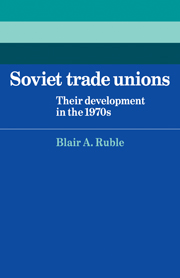Book contents
- Frontmatter
- Contents
- List of tables and figures
- Acknowledgments
- Abbreviations
- Introduction
- 1 Soviet trade union development: 1917–1956
- 2 Soviet trade union development: 1957–1980
- 3 Union–management–Party relations at the plant
- 4 The legal and social rights of Soviet workers
- 5 Do workers participate in Soviet management?
- 6 Patterns of union behavior
- 7 The international activities of Soviet trade unions
- Conclusion
- Notes
- Classified bibliography
- Index
1 - Soviet trade union development: 1917–1956
Published online by Cambridge University Press: 07 October 2011
- Frontmatter
- Contents
- List of tables and figures
- Acknowledgments
- Abbreviations
- Introduction
- 1 Soviet trade union development: 1917–1956
- 2 Soviet trade union development: 1957–1980
- 3 Union–management–Party relations at the plant
- 4 The legal and social rights of Soviet workers
- 5 Do workers participate in Soviet management?
- 6 Patterns of union behavior
- 7 The international activities of Soviet trade unions
- Conclusion
- Notes
- Classified bibliography
- Index
Summary
Unlike their Western counterparts, Soviet trade union leaders perceive the interests of the assembly-line worker and those of the Soviet state (and, through that state, factory management) as identical. Now that the workers own the means of production, trade union leaders argue, any increase in national wealth through higher productivity will be to the direct benefit of the new owners – the workers themselves. As a result, Soviet union officials view higher productivity as a preeminent goal. They also recognize, however, that individual managers may seek short-term gain at the expense of workers by introducing illegitimate managerial practices. They admit that simple administrative inefficiency may cheat some workers out of their rightful benefits. Therefore, Soviet unions acknowledge that they must defend their membership against the “bureaucratism” of management. In other words, a factory union leader in the Soviet Union must both mobilize workers behind production goals and defend those same workers against unscrupulous administrators.
This concept of dual-functioning trade unions emerged from the turmoil of the revolutions of 1917. As is well known, V. I. Lenin and the Bolsheviks staged a successful coup d'état in that year, deposing the Provisional Government of A. Kerensky. In order to gain control, however, Lenin's party needed to broaden its support while appearing to remain loyal to the self-proclaimed goal of creating a workers' state. Meanwhile, cumbersome trade union organizations in operation since the Revolution of 1905 found themselves on the verge of losing whatever support they had to factory workers' councils.
- Type
- Chapter
- Information
- Soviet Trade UnionsTheir Development in the 1970s, pp. 9 - 26Publisher: Cambridge University PressPrint publication year: 1981



